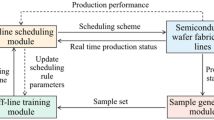Abstract
The scheduling of parallel machines and the optimization of multi-line systems are two hotspots in the field of complex manufacturing systems. When the two problems are considered simultaneously, the resulting problem is much more complex than either of them. Obtaining sufficient training data for conventional databased optimization approaches is difficult because of the high diversity of system structures. Consequently, optimization of multi-line systems with alternative machines requires a simple mechanism and must be minimally dependent on historical data. To define a general multi-line system with alternative machines, this study introduces the capability vector and matrix and the distribution vector and matrix. A naive optimization method is proposed in accordance with classic feedback control theory, and its key approaches are introduced. When a reasonable target value is provided, the proposed method can realize closedloop optimization to the selected objective performance. Case studies are performed on a real 5/6-inch semiconductor wafer manufacturing facility and a simulated multiline system constructed on the basis of the MiniFAB model. Results show that the proposed method can effectively and efficiently optimize various objective performance. The method demonstrates a potential for utilization in multi-objective optimization.
Similar content being viewed by others
References
Becker C, Scholl A. Balancing assembly lines with variable parallel workplaces: Problem definition and effective solution procedure. European Journal of Operational Research, 2009, 199(2): 359–374
Scholl A, Boysen N. Designing parallel assembly lines with split workplaces: Model and optimization procedure. International Journal of Production Economics, 2009, 119(1): 90–100
Scholl A, Fliedner M, Boysen N. Absalom: Balancing assembly lines with assignment restrictions. European Journal of Operational Research, 2010, 200(3): 688–701
Kellegöz T, Toklu B. An efficient branch and bound algorithm for assembly line balancing problems with parallel multi-manned workstations. Computers & Operations Research, 2012, 39(12): 3344–3360
Ogan D, Azizoglu M. A branch and bound method for the line balancing problem in U-shaped assembly lines with equipment requirements. Journal of Manufacturing Systems, 2015, 36: 46–54
Moghaddam M, Nof S Y. Real-time administration of tool sharing and best matching to enhance assembly lines balanceability and flexibility. Mechatronics, 2015, 31: 147–157
Avikal S, Jain R, Mishra P K, et al. A heuristic approach for U-shaped assembly line balancing to improve labor productivity. Computers & Industrial Engineering, 2013, 64(4): 895–901
Moreira M, Cordeau J, Costa A, et al. Robust assembly line balancing with heterogeneous workers. Computers & Industrial Engineering, 2015, 88: 254–263
Kucukkoc I, Zhang D Z. Balancing of parallel U-shaped assembly lines. Computers & Operations Research, 2015, 64: 233–244
Li Z, Kucukkoc I, Nilakantan J M. Comprehensive review and evaluation of heuristics and meta-heuristics for two-sided assembly line balancing problem. Computers & Operations Research, 2017, 84: 146–161
Tiacci L. Simultaneous balancing and buffer allocation decisions for the design of mixed-model assembly lines with parallel workstations and stochastic task times. International Journal of Production Economics, 2015, 162: 201–215
Chica M, Bautista J, Cordón O, et al. A multiobjective model and evolutionary algorithms for robust time and space assembly line balancing under uncertain demand. Omega, 2016, 58: 55–68
Kim Y K, Song W S, Kim J H. A mathematical model and a genetic algorithm for two-sided assembly line balancing. Computers & Operations Research, 2009, 36(3): 853–865
Chutima P, Chimklai P. Multi-objective two-sided mixed-model assembly line balancing using particle swarm optimisation with negative knowledge. Computers & Industrial Engineering, 2012, 62(1): 39–55
Huang H H, Pei W, Wu H H, et al. A research on problems of mixedline production and the re-scheduling. Robotics and Computerintegrated Manufacturing, 2013, 29(3): 64–72
Purnomo H D, Wee HM. Maximizing production rate and workload balancing in a two-sided assembly line using Harmony Search. Computers & Industrial Engineering, 2014, 76: 222–230
Tapkan P, Ozbakir L, Baykasoglu A. Modeling and solving constrained two-sided assembly line balancing problem via bee algorithms. Applied Soft Computing, 2012, 12(11): 3343–3355
Yang F, Gao K, Simon I W, et al. Decomposition methods for manufacturing system scheduling: A survey. IEEE/CAA Journal of Automatica Sinica, 2018, 5(2): 389–400
Pan C R, Zhou M C, Qiao Y, et al. Scheduling cluster tools in semiconductor manufacturing: Recent advances and challenges. IEEE Transactions on Automation Science and Engineering, 2018, 15(2): 586–601
Yang F J, Wu N Q, Qiao Y, et al. Optimal one-wafer cyclic scheduling of time-constrained hybrid multicluster tools via petrinets. IEEE Transactions on Systems, Man, and Cybernetics: Systems, 2017, 47(11): 2920–2932
Przybylski B. A new model of parallel-machine scheduling with integral-based learning effect. Computers & Industrial Engineering, 2018, 121: 189–194
Xi Y, Jang J. Scheduling jobs on identical parallel machines with unequal future ready time and sequence dependent setup: An experimental study. International Journal of Production Economics, 2012, 137(1): 1–10
Ouazene Y, Yalaoui F. Identical parallel machine scheduling with time-dependent processing times. Theoretical Computer Science, 2018, 721: 70–77
Laleh G, Daniel G. Scheduling parallel identical machines to minimize makespan: A parallel approximation algorithm. Journal of Parallel and Distributed Computing, 2018 (in press)
Wu L, Wang S. Exact and heuristic methods to solve the parallel machine scheduling problem with multi-processor tasks. International Journal of Production Economics, 2018, 201: 26–40
Cheng J, Chu F, Zhou M. An improved model for parallel machine scheduling under time-of-use electricity price. IEEE Transactions on Automation Science and Engineering, 2018, 15(2): 896–899
Ding J Y, Song S, Zhang R, et al. Parallel machine scheduling under time-of-use electricity prices: New models and optimization approaches. IEEE Transactions on Automation Science and Engineering, 2016, 13(2): 1138–1154
Wang L, Wang S Y, Zheng X L. A hybrid estimation of distribution algorithm for unrelated parallel machine scheduling with sequencedependent setup times. IEEE/CAA Journal of Automatica Sinica, 2016, 3(3): 235–246
Acknowledgements
This research was supported in part by the National Natural Science Foundation of China (Grant No. 71690230/71690234) and the International S&T Cooperation Program of China (Grant No. 2017YFE0101400).
Author information
Authors and Affiliations
Corresponding author
Rights and permissions
About this article
Cite this article
Kong, W., Qiao, F. & Wu, Q. A naive optimization method for multi-line systems with alternative machines. Front. Mech. Eng. 14, 377–392 (2019). https://doi.org/10.1007/s11465-019-0544-z
Received:
Accepted:
Published:
Issue Date:
DOI: https://doi.org/10.1007/s11465-019-0544-z




